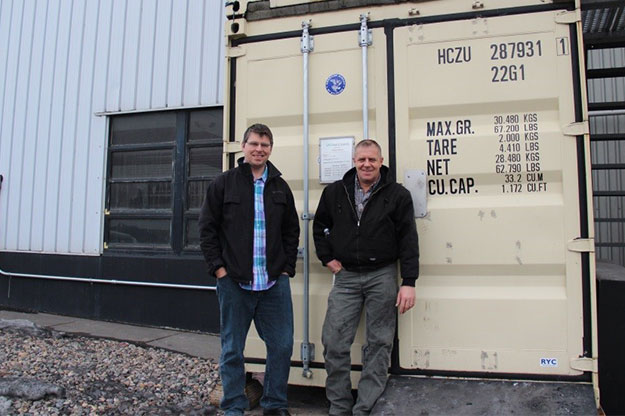Pushing the envelope on global warming
UND chemical engineer Daniel Laudal and colleagues aim to revolutionize carbon-capture technology

Advancing UND’s commitment to cleaner energy, Dan Laudal and Kirtipal Barse recently received a $55,090, nine-month grant from Envergex LLC — a green energy company — to study more efficient ways to capture carbon dioxide (CO2).
Laudal, an engineer who is major projects manager at the Institute of Energy Studies (in the UND College of Engineering & Mines), sees this research as a step in the global move to cut the impacts of human activity, including climate change.
“The purpose of this grant is to research more efficient ways to reduce carbon dioxide emissions in coal-fired electric power generation,” said Laudal, who acknowledges his dad Dennis’ career as an inspiration. Dennis Laudal retired two years ago from the UND Energy & Environmental Research Center (EERC) after a 37-year career. Daniel worked there for four years after finishing his chemical engineering degree at UND in 2006.
The technology that Laudal and Barse, a research engineer in the Chemical Engineering Department, are researching separates CO2 from the gas stream emitted from a coal-fired plant. They then produce a stream of pure CO2 that can be permanently stored underground or used for Enhanced Oil Recovery.
“A big problem with current systems is that in coal combustion there are inorganic substances in the coal: sulfur, potassium, sodium, etc., that, when burned, produce minute particles (1 millionth of a meter),” said Laudal. “When these particles travel into post-combustion CO2 capture systems used to ‘scrub’ the flue gases, they cause many problems.”
Among these problems: some of the toxic solvents are wasted, both an environmental and an economic problem (it’s expensive to replace the wasted solvent), Laudal noted.
“We’re trying to find ways to stop these tiny particles, called ‘aerosols’, from getting into the CO2 scrubber,” Laudal said.
“Here at UND, we’re using a solid sorbent, a material that will react with the aerosols before those particles get into the post-combustion capture system,” Laudal said. “Once reacted with the solid sorbent, the power plant’s existing air pollution control system is able to capture them with high efficiency.”
The team is in Phase 1 of the research.
“This is when we prove our concept,” said Laudal, who spent a couple of years in the oilfields after graduation.
Eventually, Laudal says, this technology could be scaled up for commercial usage. For example, it could be used in a large coal-fired power plant, such as the Milton R. Young in central North Dakota.
“We’ve already got a letter of support from Minnkota, which operates the Milton Young plant,” he said. “Carbon dioxide emissions are a problem, but our goal is to find a way to burn coal without that hazard and still get economic value out of existing plants and the vast coal resources in North Dakota.”
He’s focused on the future.
“The science is pretty clear that our planet is warming — not up for discussion, even though some may disagree,” Laudal said. “The consequences of not doing something now may be severe.”
by Juan Miguel Pedraza


